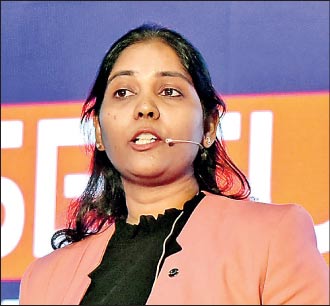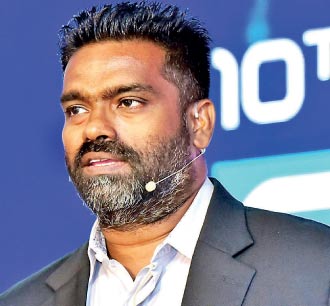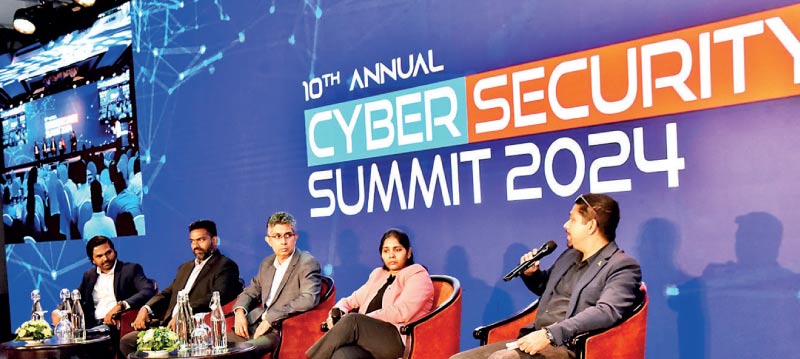Sunday Apr 20, 2025
Sunday Apr 20, 2025
Monday, 20 January 2025 04:51 - - {{hitsCtrl.values.hits}}

Just in Time Group CEO Neranjan Dissanayake

Sysco LABS Cybersecurity Director Shanthi Rajesh

NCINGA CEO Harindha Fernando

NCINGA Director and CISO Aruna Malasena

From left: Moderator CyberLabs Principal Consultant Mohan Chathuranga, NCINGA CEO Harindha Fernando, X.O Concepts Director and Chief Technology Officer Dilan Walgampaya, Sysco LABS Cybersecurity Director Shanthi Rajesh, and NCINGA Director and CISO Aruna Malasena
|
X.O Concepts Director and Chief Technology Officer Dilan Walgampaya |
|
CyberLabs Principal Consultant Mohan Chathuranga
|
By Hiyal Biyagamage
It is no wonder that the digital landscape evolves at an unprecedented pace and with that, the convergence of artificial intelligence (AI) and cybersecurity is emerging as a transformative force in safeguarding our interconnected world. With cybercrime costs projected to reach an astronomical $ 10.5 trillion annually by 2025, according to Cybersecurity Ventures, the stakes have never been higher.
At the same time, AI’s market value is expected to surpass $ 1.5 trillion within the same timeframe, underlining its growing dominance in every industry. This convergence represents a dual-edged sword: while AI offers unprecedented capabilities for detecting, preventing, and mitigating cyber threats, it also equips malicious actors with new tools for sophisticated attacks. The critical question is no longer whether AI will shape the future of cybersecurity, but how effectively it can be harnessed to build a resilient digital ecosystem.
In such a background, the third session of the 10th Daily FT-CICRA Annual Cybersecurity Summit discussed these challenges and explored the potential of AI-driven solutions to combat escalating cyber threats.
Rising to meet evolving threats
The session began with Sysco LABS Director of Cybersecurity Shanthi Rajesh, presenting on “Cybersecurity in the Age of AI.” She painted a sobering picture of the modern threat landscape, emphasising the growing prevalence of advanced persistent threats (APTs), zero-day exploits, and ransomware attacks.
Rajesh highlighted how AI has become an essential tool in cybersecurity, enabling real-time threat detection and response. By analysing vast datasets from user behaviour logs, network traffic, and system configurations, AI establishes a baseline of normal behaviour for an organisation’s digital environment. This allows it to detect anomalies that might indicate malicious activity. Her presentation delved into AI’s advanced techniques, such as machine learning, computer vision, and natural language processing (NLP), to identify and mitigate threats.
However, Rajesh cautioned against overreliance on AI, pointing out significant challenges like data bias, lack of explainability in AI decisions, and the constant evolution of threats. She underscored the importance of continuous training for AI systems to adapt to new attack vectors. “AI-powered systems must learn and evolve as quickly as the attackers do,” she noted.
Securing AI-driven transformation
NCINGA’s Chief Executive Officer Harindha Fernando and Vice President of Cybersecurity and Enterprise Aruna Malasena took the stage next, offering insights into how industries can navigate the challenges of AI-driven transformation. Their presentation, titled “Securing AI-Driven Transformation: A Sample Industry Use Case,” focused on the banking sector as a model for next-generation security strategies.
“Trust is the foundation of every digital interaction,” Fernando asserted. As AI continues to take over tasks traditionally performed by humans, maintaining trust in confidentiality, integrity, and availability becomes paramount. The duo introduced their “Secure by Design” approach, a framework that emphasises continuous verification and real-time adaptation to evolving threats.
One of the standout elements of their talk was the “AI-Driven Bank of the Future” use case. This concept showcased how banks can leverage AI to predict and mitigate risks while ensuring operational stability during rapid technological shifts. Their presentation also highlighted tools like the ATLAS matrix to design resilient, adaptive systems capable of responding to emerging cyber threats.
Empowering decision-makers with AI
The final presentation of the session, delivered by Just In Time Group CEO Neranjan Dissanayake, shifted the focus to board-level strategies for integrating AI into cybersecurity. In his talk, “Empowering Boards: How AI Enhances Decision-Making in Cybersecurity, Risk, and Insurance,” Dissanayake illustrated how AI can help organisations make informed decisions in a landscape dominated by ever-increasing cyber risks.
Dissanayake began by presenting eye-opening statistics, such as a projected $ 10.5–12 trillion in cyberattack damages by 2025. He argued that the rising frequency and sophistication of cyber threats necessitate a paradigm shift in how organisations approach risk management and governance.
AI, according to Dissanayake, is a game-changer for boards of directors, offering Real-Time Insights, Risk Prioritisation and Proactive Compliance Monitoring.
One of the more innovative aspects of his presentation was the use of AI in optimising cyber insurance policies. By analysing a company’s risk profile and historical claims data, AI can recommend cost-effective coverage options, streamline claims processing, and even negotiate better premiums. “This level of integration between AI and governance represents the future of effective cybersecurity management,” Dissanayake concluded.
Overarching themes and takeaways
While each speaker brought unique perspectives to the table, several common themes emerged. AI’s role in cybersecurity, from real-time threat detection to strategic planning, is no longer optional. Organisations must embrace it to stay ahead of increasingly sophisticated attackers. At the same time, ethical considerations were emphasised by all speakers. Transparency in decision-making processes and accountability for AI-driven actions were highlighted as critical to building trust in this evolving technological landscape. Despite AI’s advanced capabilities, human oversight remains indispensable. Cybersecurity professionals must work alongside AI to address its limitations, such as data bias and explainability.
Adaptability was another key takeaway, as both AI systems and the organisations deploying them must continuously evolve to keep pace with emerging cyber threats. Additionally, the session underscored the importance of cross-industry collaboration. By sharing threat intelligence across sectors, organisations can build a more resilient global cybersecurity ecosystem. Together, these themes provide a roadmap for leveraging AI to enhance cybersecurity while maintaining ethical integrity and fostering cooperative efforts.
The road ahead
As the third session of the summit demonstrated, the convergence of AI and cybersecurity offers unparalleled opportunities to safeguard digital ecosystems. However, it also presents new challenges that require thoughtful consideration and proactive measures.
From Shanthi Rajesh’s exploration of AI’s technical capabilities to Harindha Fernando and Aruna Malasena’s industry-specific insights and Neranjan Dissanayake’s governance-focused strategies, the session provided a comprehensive roadmap for leveraging AI in the fight against cyber threats. The message was clear: cybersecurity is not just about technology; it’s about people, policies, and preparation.
As organisations navigate the complexities of an increasingly digital world, the lessons shared at the summit serve as a vital reminder of what’s at stake. With cybercrime costs projected to surpass $ 10 trillion annually by 2025, the time to act is now. The fusion of AI and human expertise will be the cornerstone of a secure and resilient digital future.
Strategic partners of the CEO Forum and the 10th Annual Cyber Security Summit were Visa,
Belkasoft, the platinum partners were Huawei and Google Cloud, Gold Partner was Sysco LABS, and Silver Partners were Millennium IT ESP, NCinga, and Just In Time Group. People’s Bank was the Banking Partner, LankaPay was the Official Payment Network Partner whilst Platform Provider was HashX. Electronic media partners were Sirasa TV, TV1 and NewsFirst, while the Podcast Partner was TechTalk360, and Brand Communications Partner was MullenLowe Sri Lanka.
Pix by Ruwan Walpola
Discover Kapruka, the leading online shopping platform in Sri Lanka, where you can conveniently send Gifts and Flowers to your loved ones for any event including Valentine ’s Day. Explore a wide range of popular Shopping Categories on Kapruka, including Toys, Groceries, Electronics, Birthday Cakes, Fruits, Chocolates, Flower Bouquets, Clothing, Watches, Lingerie, Gift Sets and Jewellery. Also if you’re interested in selling with Kapruka, Partner Central by Kapruka is the best solution to start with. Moreover, through Kapruka Global Shop, you can also enjoy the convenience of purchasing products from renowned platforms like Amazon and eBay and have them delivered to Sri Lanka.
Discover Kapruka, the leading online shopping platform in Sri Lanka, where you can conveniently send Gifts and Flowers to your loved ones for any event including Valentine ’s Day. Explore a wide range of popular Shopping Categories on Kapruka, including Toys, Groceries, Electronics, Birthday Cakes, Fruits, Chocolates, Flower Bouquets, Clothing, Watches, Lingerie, Gift Sets and Jewellery. Also if you’re interested in selling with Kapruka, Partner Central by Kapruka is the best solution to start with. Moreover, through Kapruka Global Shop, you can also enjoy the convenience of purchasing products from renowned platforms like Amazon and eBay and have them delivered to Sri Lanka.